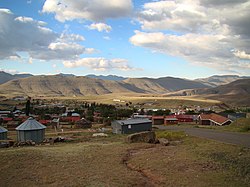Mokhotlong


Cradled in the mountains of Southern Africa, Mokhotlong is one of Lesotho’s ten districts, located in the northeastern part of the country. It is the first major town along the road from South Africa across the Sani Pass, near the Maloti (Drakensberg in South Africa) Mountains. The name of the city is a word in Sesotho, the language of the people of Lesotho, meaning "Place of the Bald Ibis."
History
Mokhotlong’s role as a police post first brought people to this part of Lesotho in 1905. It developed into a trading center for the people of the Highlands region. However, it was preserved from major development by its separation from the rest of the country. Not until 1947 was radio contact established with Maseru, the capital city.
In the next few years an air strip was built and a road cleared through town to link Mokhotlong to the rest of Lesotho. Even so, Mokhotlong continued to be outfitted with provisions and supplies by pony trek from Natal, South Africa, via Sani Pass.[1]
Geography
An hour and a half drive north of Sani Pass, Mokhotlong is located 270 km from Maseru and 200 km from Butha-Buthe. The source of the Senqu River, Lesotho’s largest river, is near Mokhotlong, impacting the landscape throughout the town and surrounding district. [2]
Things to Do
The mountain range is host to activities including hiking trails, horse trails, rock climbing, white water rafting, fly and trout fishing, golfing, bird and game watching, safaris, and much more.[3]
In addition to regular activities, Mokhotlong hosts the annual High Altitude Summer Marathon at the end of the year. The route runs through the Maloti Mountains and is characterized by great views of both mountains and villages. At 3000 meters above sea level, if the scenery does not take the runner’s breath away, the steep ascents and descents will. There are also half marathon and 10k events, in addition to the full marathon.
Mokhotlong is also on the route of the annual Roof of Africa Rally, an off-road motorcycle rally. Finally, Mokhotlong is home to the highest-elevated diamond mine in the world, Letseng diamond mine, which can be toured, and is often frequented by local students as part of their course of study. Its diamonds have the highest per carat price of any kimberlite mine, and with the capacity to process more than 5 million tonnes a year and recover about 100,000 carats, it is the seventh largest in the world. Three of their diamonds are among the world’s top twenty rough diamonds.
Economy
Mokhotlong's economy is primarily driven by livestock rearing and subsistence agriculture, though neither of these fully supports most families. Arable land in this mountainous region is a scarce resource. Agricultural production only sustains families from 3 to 9 months of the year. Families cover the gap largely through livestock and remittances from employed family members. However, livestock distribution is skewed with 60% of the livestock owned by 10% of the population; approximately 35% of the families have no livestock. Remittances are thought to be small, given both poor educational opportunities and the high unemployment rate in Lesotho and in South Africa. Consequently, a large segment of the population is seriously poor. [4] This is exacerbated by HIV/AIDS, which ravages the region. Despite its poverty, few aid organizations work in Mokhotlong. Touching Tiny Lives provides nutritional and medical support to vulnerable children. GROW works with villages to increase agricultural production.
In Mokhotlong Town, the district capital, the economy is boosted by the presence of government offices.
References
- ^ McCrea, Mthembu-Salter, Pinchuck, Reid (1999). South Africa, Lesotho, & Swaziland: The Rough Guide. London: Penguin Books Ltd. pp. 644–646. ISBN 1-85828-460-0.
{{cite book}}: CS1 maint: multiple names: authors list (link) - ^ Murray, Williams, Everist (1998). South Africa, Lesotho, & Swaziland. Hawthorn, Australia: Lonely Planet. pp. 609–610. ISBN 0-86442-508-2.
{{cite book}}: CS1 maint: multiple names: authors list (link) - ^ "South Africa: Discover Our Drakensberg". Retrieved 7/6/2011.
{{cite web}}: Check date values in:|accessdate=(help) - ^ GROW Annual Reports: 1997-98, 1999-2000, 2000-2001
